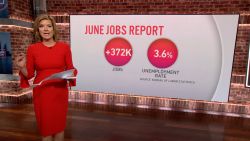Next week, job seekers will start to get a much better grasp on what many employers are willing to pay – and so will a company’s existing employees.
While there is already a patchwork of state and local laws aimed at improving pay transparency, many companies still do not advertise what they pay up front. But two new laws that will soon take effect may have the biggest impact yet on employers and job seekers across the country.
On November 1, New York City will require employers that have four or more people on the payroll – with at least one of them working in the city – to provide a “good faith” pay range listing the minimum and maximum base salary or hourly wage in all job advertisements.
Then come January 1, 2023, a similar law goes into effect in California for employers with at least 15 employees. Organizations will be required to include the salary or hourly wage range for what they “reasonably expect” to pay for a position.
Both laws will be far reaching, because they affect two of the most populous places in the US and will apply to companies that issue job postings that can or will be performed in New York City or California, or potentially would attract applicants who live there.
The upshot: “Thousands of employers” across the US will be affected, even if they’re not headquartered in New York City or California but simply do business there, said Joy Rosenquist, special counsel at employment law firm Littler Mendelson PC.
Open questions and workarounds
While the New York City and California laws are going to increase pay transparency, they also are raising many compliance questions for employers.
“A lot of gray areas need to be worked out,” Rosenquist said. She noted that the California law, for instance, is not as clear as it needs to be on how job advertisements for remote positions must be handled.
And just because employers will need to share pay information up front doesn’t mean it will be presented in the same way, said John Haney, a labor and employment attorney at Holland & Knight.
Employers set pay based on many factors like competition for labor in a given locale as well as legal requirements. For instance, Haney said, they legally can’t make a position exempt from overtime unless it pays above a certain threshold (which differs from state to state) and it meets a so-called duties test, which clarifies that the position can’t primarily include duties more typical of overtime-eligible jobs.
So companies may end up displaying several ranges based on location, Haney said.
What’s more, since market adjustments to pay can occur quickly, “an employer could be in violation of the law if the pay scale was changed after the initial job posting is published,” said Emily Dickens, head of government affairs at the Society for Human Resource Management, in an August letter to California lawmakers.
Or for some jobs, employers may get around the new requirement. Under the New York City law, for instance, employers don’t have to disclose pay ranges if they don’t advertise the job in writing.
“A personal outreach, [such as] a phone call or a conversation would not be covered as it is not a written advertisement,” said attorney Carol Goodman, a partner at Herrick, Feinstein LLP.
But, she added, it’s not clear whether a personal outreach by letter or email would require disclosure.
And while the law will apply to any ads put out by an employment agency or recruiting firm retained by an employer seeking to hire, there is an exception made for temp agencies when recruiting “applicants to join their pool of available workers,” according to the New York City Commission on Human Rights.
Changing the conversation on pay
The new laws will change the conversation around compensation for both job seekers and current employees. “It will make it more constructive,” said Allison Rutledge-Parisi, senior vice president of people at Justworks, a cloud-based platform providing payroll, benefits, compliance and human resources help to small businesses.
Applicants no longer will have to invest weeks or months in a recruitment process before finding out what a potential employer is willing to pay them. Publicly disclosing salary may dissuade some well-qualified candidates from applying in the first place if the advertised range is lower than what they’re looking for, SHRM’s Dickens noted. Then again, if a company is finding it hard to attract the right talent at the publicly advertised pay range, it may need to revisit what a competitive range is.
And for current employees of companies advertising jobs, they now have a reference point to start the discussion about their own pay with their manager, whereas before they had a hard time figuring out if they’re being paid competitively.
“It’s so powerful. … Now you have real data to go with,” said Laura Mazzullo, owner of recruiting firm East Side Staffing. “This will empower those who never knew how to ask for more.”
But employers need to educate managers about the organization’s pay policies and how to answer likely questions from employees who may wonder, for instance, why their current salary is at the low end of the range that the company is advertising for the same role.
If the answer to that question is that those who are paid on the higher end of the range bring a special skillset to the role, the manager might then discuss what the employee needs from the company by way of training or experience to move up the pay scale and set them up for that, Rutledge-Parisi suggested.
If, however, a manager can’t clearly explain why there are pay discrepancies for the same role and if a company doesn’t cure unjustified gaps between what current staff make versus what new hires are paid, morale will suffer.
“I think we’ll see massive amounts of turnover unless employers are willing to pay up to market,” Mazzullo said.
At the same time, she added, the new laws may cause companies to initially slow hiring a bit as they figure out the ins and outs of these new requirements, especially for companies that realize they have pay equity problems. “From a CFO’s lens, this will be complicated,” Mazzullo said.
Correction: The original version of this article incorrectly spelled Laura Mazzullo's last name.


























